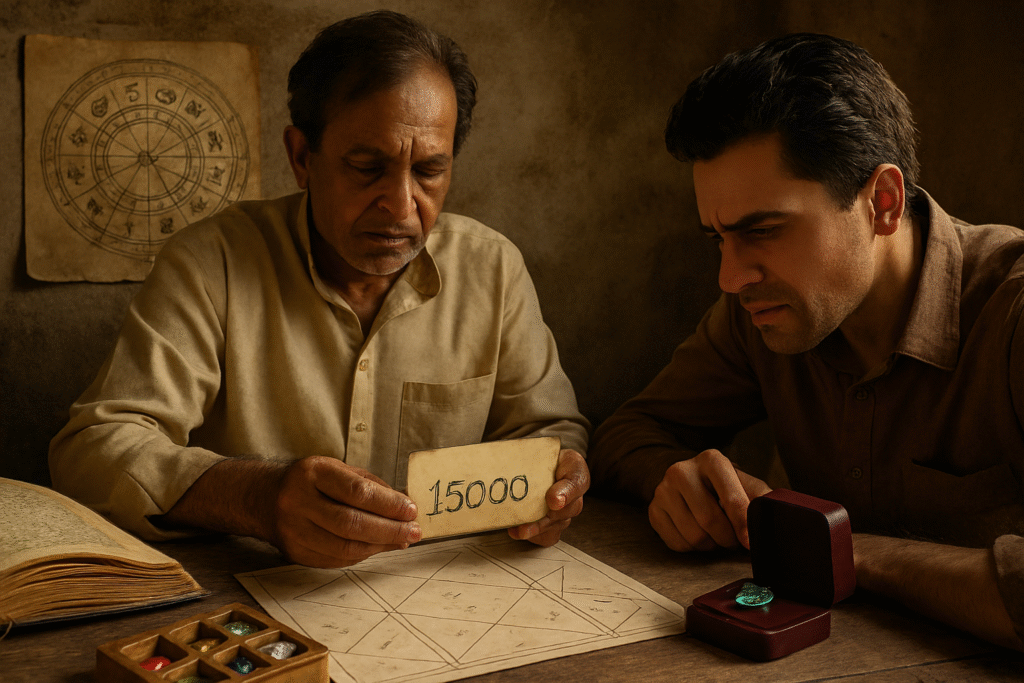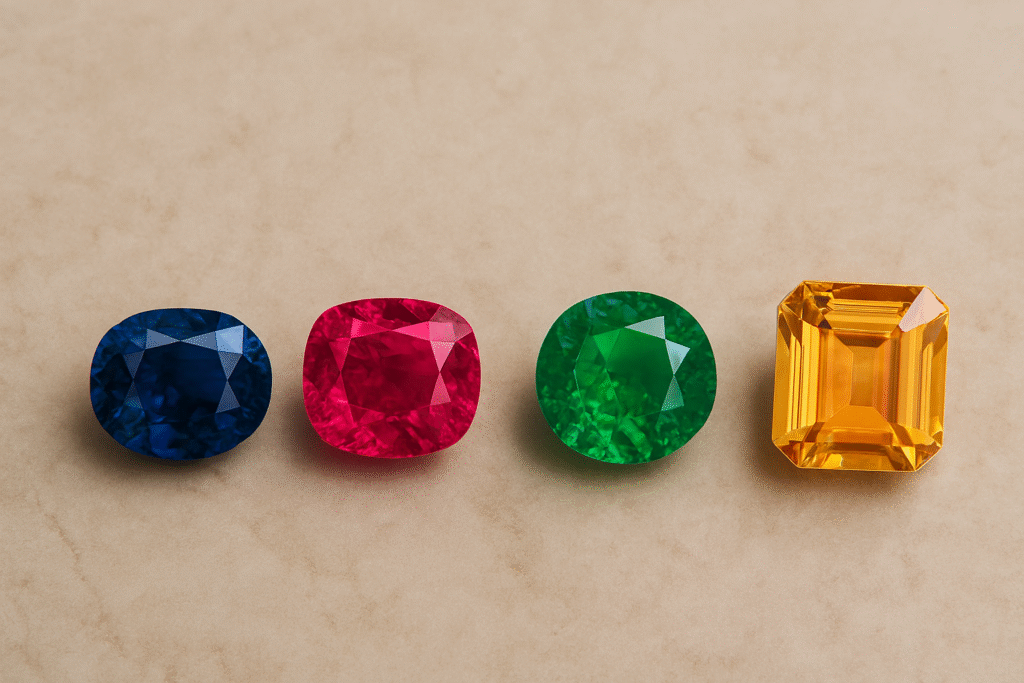When shopping for gems and jewelry, you need to follow practical rules that protect your money and guarantee quality.
- Always buy from a trusted jeweler
- Always ask for a detailed receipt
A reliable jeweler gives you authenticity and accountability. A proper receipt documents purity, gemstone type, and any warranty.
How to Inspect Jewelry Before Buying
Use a 10x magnifying lens. Check:
- Settings: Are the stones held firmly?
- Metal markings: Look for purity marks such as 22K, 18K, 925 (silver), or Pt950 (platinum).
- Maker’s mark: A traceable hallmark adds credibility.
- Stones: Examine for chips, cracks, or flaws that affect beauty and durability.
💡 The key is simple: You rarely find bargains in the gem world. Quality comes at a fair price.
Why Low Prices Can Be Risky
Cheaper jewelry may signal:
- Lower quality materials
- Incorrect labeling (e.g., citrine sold as topaz, or green glass sold as jade)
- Misleading trade names
Research shows that over 60% of jewelry complaints involve misrepresentation of gems.
Understanding Gemstone Value
The value of a gemstone depends on:
1. Color
- Strong, natural colors fetch higher prices.
- Lighting affects how you see color. Always check under natural light.
2. Clarity
- Diamonds, topaz, aquamarine, and tanzanite are judged strictly on inclusions.
- Emeralds and red tourmalines almost always show inclusions, so grading is more lenient.
3. Cut
- Proportions and finish affect sparkle and durability.
- Poorly cut stones may break more easily.
- A high-quality cut improves brilliance by up to 30% compared to average cuts.
4. Carat Weight
- Larger gems cost more per carat because they’re rarer.
- Stones above 40 carats may drop in value if they become impractical for jewelry use.
Case Example: Emeralds
An emerald with vivid green color but visible inclusions can cost more than a flawless light-colored stone. The market pays for intensity of color, not just clarity.
FAQ: Shopping for Gems and Jewelry
Q: What documents should I ask for when buying jewelry?
A: Always request a bill with details on purity, stone weight, and certification.
Q: Are bargains in gemstones real?
A: Rarely. A low price often means poor quality or misrepresentation.
Q: Which factor affects gemstone price the most?
A: Color. For example, a fine blue sapphire can be 50% more expensive than a similar but paler stone.
Q: How do I avoid buying fake jade?
A: Ask for a gemological certificate and avoid vague labels like “jade-like stone.”
Quotable Insights
- “You rarely find true bargains in the gem market. Value is tied to quality and trust.”
- “Color is the single biggest driver of a gemstone’s price.”
- “A skilled cut can increase brilliance by 30% or more.”
Introduction
This comprehensive Watch Buying Guide answers the most common questions about timepieces.
Whether you’re purchasing your first watch or adding to your collection, these expert insights help you make informed decisions.
From understanding movement types to choosing the right size for your wrist, you’ll find everything needed before making a purchase.
What Types of Watches Should You Consider? – Watch Buying Guide Insights
Understanding the five main categories helps narrow your options:
- Mechanical watches – Use springs and gears. No battery needed.
- Quartz watches – Battery-powered; most accurate.
- Automatic watches – Wind themselves from wrist movement.
- Digital watches – Display time numerically on a screen.
- Smartwatches – Connect to your phone and track fitness data.
Accuracy Expectations – Watch Buying Guide Tips
- Quartz watches – Lose about 15 seconds per month.
- Mechanical watches – Lose 20–40 seconds per day.
- Atomic watches – Lose 1 second every 100 million years.
- Your phone’s clock stays perfectly accurate.
Water Resistance Considerations
Water resistance ratings affect usage scenarios:
- 30m – Handles rain and handwashing
- 50m – Safe for swimming
- 100m – Suitable for snorkeling
- 200m+ – Scuba diving
Replace gaskets every 2–3 years to maintain resistance.
Maintenance Schedule – Watch Buying Guide Advice
- Quartz watches – Battery replacement every 1–3 years.
- Mechanical watches – Full service every 3–5 years.
- Service costs: $200–800 depending on the brand.
Watch for stopping, running fast/slow, or condensation under the crystal.
Pricing Strategy
- Budget watches – Plastic cases, basic movements
- Mid-range watches – Steel cases, reliable mechanisms
- Luxury watches – Precious metals, hand-finished details
Remember: craftsmanship, materials, and brand prestige drive prices.
Sizing Advice
- 6–7 inch wrists – 38–42mm
- 7–8 inch wrists – 40–44mm
- 8+ inch wrists – 42–46mm
Ensure lugs don’t overhang wrist edges.
Complications to Prioritize
- Date display – Useful daily
- GMT hand – Second time zone
- Chronograph – Stopwatch
- Moon phase – Decorative
- Annual calendar – Adjusts month lengths
More complications = more things that can break.
Maintenance Tips
- Clean with a soft cloth
- Avoid extreme temperatures & magnets
- Wind manual watches daily
- Use watch winders for automatics
- Don’t adjust date between 9 PM–3 AM
Investment Potential
- Most watches lose value after purchase
- Only select Rolex, Patek Philippe, Audemars Piguet models appreciate
- Vintage watches from 1960s–70s show strong growth
- Buy watches you enjoy wearing, not solely for investment
Essential Tools
- Spring bar tool
- Case back opener
- Soft polishing cloth
- Watch cushion
- Demagnetizer
Where to Purchase
- Online – Better selection, often cheaper
- Physical stores – Try before buying
- Authorized dealers – Full warranties
- Grey market – Discounts, limited warranty
- Forums/eBay – Vintage pieces, verify authenticity
Learn More:



